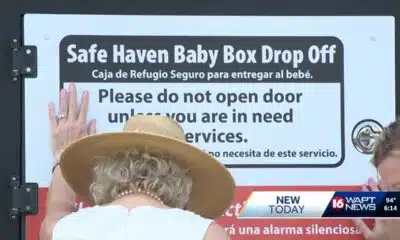News from the South - Alabama News Feed
Race and place can contribute to shorter lives, research suggests • Alabama Reflector
Race and place can contribute to shorter lives, research suggests
by Tim Henderson, Alabama Reflector
January 30, 2025
This story originally appeared on Stateline.
There’s growing evidence that some American demographic groups need more help than others to live longer, healthier lives.
American Indians in Western and Midwestern states have the shortest life expectancy as of 2021, 63.6 years. That’s more than 20 years shorter than Asian Americans nationwide, who can expect to live to 84, according to a recent study by the Institute for Health Metrics and Evaluation at the University of Washington.
White residents live shorter lives in Appalachia and some Southern states, as do Black residents in highly segregated cities and in the rural South, the study found.
GET THE MORNING HEADLINES.
The data illustrates how Americans’ life expectancy differs based not only on race, but also on geography.
“Not everybody in this country is doing exactly the same even within a racial group, because it also depends on where they live,” said Dr. Ali Mokdad, an author of the study and the chief strategy officer for population health at the University of Washington.
“Eliminating these disparities will require investing in equitable health care, education, and employment, and confronting factors that fuel inequalities, such as systemic racism,” the report, which was published in November, concluded.
Yet the United States is seeing a surge of action this month to pull back on public awareness and stem investments in those areas.
In President Donald Trump’s first two weeks, he has stripped race and ethnicity health information from public websites, blocked public communication by federal health agencies, paused federal research and grant expenditures, and ordered a ban on diversity, equity and inclusion programs across the board, all of which can draw attention — and funding — to the needs of specific demographic groups.
The administration has removed information about clinical trial diversity from a U.S. Food and Drug Administration website, and has paused health agencies’ communications with the public and with medical providers, including advisories on communicable diseases, such as the flu, that disproportionately affect underserved communities.
The new administration’s policies are headed the wrong way, said Dr. Donald Warne, a physician and co-director of the Johns Hopkins Center for Indigenous Health. “With the stroke of a pen, they’re gonna make it worse.”
One of Trump’s actions on his first day in office was to dismantle equity programs, including reversing a 2021 Biden executive order promoting more federal support for Indigenous education, including tribal colleges and universities.
The problems Indigenous people face are inextricably linked to “toxic stress” and “just pure racism,” Warne said. “Less access to healthy foods, just chronic stress from racism and marginalization, historical trauma — all of these things lead to poor health outcomes.”
The South Dakota county where Warne grew up as a member of the Oglala Lakota tribe (the county is named after the tribe) has one of the lowest life expectancies in the country, 60.1 years as of 2024, according to localized estimates from County Health Rankings & Roadmaps, an initiative of the University of Wisconsin’s Population Health Institute.
’10 Americas’
The Institute for Health Metrics and Evaluation study parceled the country into what it called “10 Americas,” each with different 2021 life expectancies.
Black Americans were represented by three groups; those in the rural and low-income South had the worst life expectancies (68 years) compared with those living in highly segregated cities (71.5) and other areas (72.3).
Racism is still a major contributor to inequitable health outcomes, and without naming it and addressing it, it will make it more difficult to uproot it.
– Dr. Mary Fleming, director of Harvard T.H. Chan School of Public Health’s Leadership Development to Advance Equity in Health Care
Asian Americans nationwide have the longest life expectancy at 84, yet can also suffer from stereotypes and locality based problems that prevent them from getting the best care, said Lan Ðoàn, an assistant professor in the Department of Public Health Section for Health Equity at New York University’s Grossman School of Medicine.
Considering Asian Americans as a single entity masks health differences, such as the high incidence of heart disease among South Asians and Filipino Americans, she said, and discourages the necessary study of individual groups.
“It perpetuates the ‘model minority’ myth where Asian people are healthier, wealthier and more successful than other racial groups,” Ðoàn said.
That’s another reason for alarm over the new administration’s attitude about health equity, said Dr. Mary Fleming, an OB-GYN and director of Harvard T.H. Chan School of Public Health’s Leadership Development to Advance Equity in Health Care program.
“With DEI (diversity, equity and inclusion programs) under attack, it hinders our ability to name a thing, a thing,” Fleming said. “Racism is still a major contributor to inequitable health outcomes, and without naming it and addressing it, it will make it more difficult to uproot it.”
Among white people and Hispanics, lifespans differ by region, according to the “10 Americas” in the Institute for Health Metrics and Evaluation study. Latinos live shorter lives in the Southwest (76) than elsewhere (79.4), and white people live longer (77.2) if they’re not in Appalachia or the lower Mississippi Valley (71.1), or in rural areas and low-income Northern states (76.7).
!function(){“use strict”;window.addEventListener(“message”,(function(a){if(void 0!==a.data[“datawrapper-height”]){var e=document.querySelectorAll(“iframe”);for(var t in a.data[“datawrapper-height”])for(var r=0;r An earlier Stateline story reported that policy, poverty, rural isolation and bad habits are shortening lives in West Virginia compared with New York. Even though the states had very similar life expectancies in 1990, West Virginia is projected to be at the bottom of the rankings by 2050, while New York is projected to be at the top. More research at a very local level is needed to find the policies and practices needed to start bridging longevity gaps, said Mokdad, the study author. Since poverty seems to dictate so much of life expectancy, it’s fruitful to look at places where lifespans have grown in recent decades despite high poverty, Mokdad said. For example, lifespans have increased in the Bronx, New York, and Monongalia County, West Virginia, despite high poverty. By contrast, they have dipped in relatively high-income areas such as Clark County, Indiana, and Henry County, Georgia. Clark County, on the Kentucky border, has a mix of urban and rural health issues that belie the relatively high income of some residents near Louisville, said Dr. Eric Yazel, health officer for the county and an emergency care physician. Part of the county is also very rural, in a part of Indiana where there was an HIV outbreak among intravenous drug users in 2014. “In a single county we see public health issues that are both rural and urban,” Yazel said. “As with a lot of areas along the Ohio River Valley, we were hit hard by the opioid epidemic and now have seen a resurgence of methamphetamine, which likely contributed to the [life expectancy] decreases.” Nationally, a spike in overdoses has begun to ease in recent years, but only among white people. Overdose death rates among Black and Native people have grown. Indigenous people also were the hardest hit during the COVID-19 pandemic, with expected lifespans dropping almost seven years between 2019 and 2021. Calvin Gorman, 50, said several friends his age in Arizona’s Navajo Nation died needlessly in the pandemic. He blames it on alcohol and pandemic isolation. “They said to just stay inside. Just stay inside. Some of them took some bottles into the house and they never came out again. I heard they died in there,” said Gorman, who commutes on foot and by hitchhiking from his home in Fort Defiance, Arizona, to a job at a gas station in Gallup, New Mexico. Warne, the Oglala Lakota physician from South Dakota, said alcohol and substance use may have been one factor in Native deaths during the pandemic, as people “self-medicated” to deal with stress. But overall, he said, the main drivers of early deaths in Native communities are high rates of infant mortality, road accidents and suicides. Warne now lives and practices medicine in North Dakota. “There’s a huge challenge for people who grow up in these settings, but many of us do move forward,” Warne said. “A lot of us wind up working in other places instead of in our home, because there just aren’t the opportunities. We should be looking at economic development as a public health intervention.” Stateline is part of States Newsroom, a nonprofit news network supported by grants and a coalition of donors as a 501c(3) public charity. Stateline maintains editorial independence. Contact Editor Scott S. Greenberger for questions: info@stateline.org. YOU MAKE OUR WORK POSSIBLE. Alabama Reflector is part of States Newsroom, a nonprofit news network supported by grants and a coalition of donors as a 501c(3) public charity. Alabama Reflector maintains editorial independence. Contact Editor Brian Lyman for questions: info@alabamareflector.com. The post Race and place can contribute to shorter lives, research suggests • Alabama Reflector appeared first on alabamareflector.comHyperlocal health problems
News from the South - Alabama News Feed
When hospitals buy physician practices, prices go up
by Anna Claire Vollers, Alabama Reflector
August 7, 2025
This story originally appeared on Stateline.
As more hospitals have gobbled up private physician practices, costs for childbirth and other services have gone up, according to a new study.
Since the early aughts, the share of physicians in the United States working for hospitals has nearly doubled, according to the study published by the National Bureau of Economic Research, a nonprofit research organization.
And as fewer doctors work in physician-owned practices, patients or their insurers end up paying more, the study’s authors found.
GET THE MORNING HEADLINES.
For example: Two years after a hospital buys an OB-GYN practice, prices for labor and delivery jump an average of $475 and physician prices rise by $502, according to the study. Researchers focused on births, which are the most common reason for hospital admission among people with private insurance.
This rapid acquisition by hospitals is reshaping a U.S. industry once dominated by tens of thousands of small, physician-owned practices.
Only about 42% of U.S. physicians work in a physician-owned private practice, according to the most recent survey data from the American Medical Association. Nearly 47% work for hospitals, a sharp rise over the past several years. Most emergency room physicians are now employed by hospital systems or by private equity-owned staffing groups.
The new research offers further evidence for how hospital acquisitions of private practices “can result in anticompetitive price increases,” said Matthew Grennan, one of the study’s authors and an associate professor of economics at Emory University, in a news release.
“As a result, I think economists and others in the antitrust community are likely to give more careful consideration to these potential sources of harm,” he said.
Medical debt is a leading cause of bankruptcy in the United States, with about 14 million Americans owing more than $1,000 in medical debt, according to research nonprofit KFF.
These post-merger price increases are driven by reduced competition, Grennan and his fellow researchers found. Yet there’s been little effort by federal or state regulators to halt hospital mergers that could lead to higher prices for consumers.
But states have taken some steps toward lowering medical costs in recent years.
Bipartisan groups of lawmakers in more than a dozen states have addressed so-called “facility fees,” which are charges that some hospitals tack on for patient visits to hospital-owned physician offices.
This year in Oklahoma, Republican lawmakers passed a bill requiring hospitals to make the cost of many of their services more transparent to patients so they’re aware of the costs. Providers can face penalties for noncompliance. A similar Oklahoma law authored by Democrats and passed last year requires debt collectors to submit evidence of a hospital’s compliance with price transparency rules before filing to collect on medical debts from patients.
Some states have capped the rates hospitals or physicians can charge. Colorado sets provider and hospitals rates based on a specific formula if insurance plans aren’t able to lower peoples’ premiums to a certain level, while Montana and Oregon limited the amount hospitals and other providers can charge for their state employee health plan.
Stateline reporter Anna Claire Vollers can be reached at avollers@stateline.org.
Stateline is part of States Newsroom, a nonprofit news network supported by grants and a coalition of donors as a 501c(3) public charity. Stateline maintains editorial independence. Contact Editor Scott S. Greenberger for questions: info@stateline.org.
Alabama Reflector is part of States Newsroom, a nonprofit news network supported by grants and a coalition of donors as a 501c(3) public charity. Alabama Reflector maintains editorial independence. Contact Editor Brian Lyman for questions: info@alabamareflector.com.
The post When hospitals buy physician practices, prices go up appeared first on alabamareflector.com
Note: The following A.I. based commentary is not part of the original article, reproduced above, but is offered in the hopes that it will promote greater media literacy and critical thinking, by making any potential bias more visible to the reader –Staff Editor.
Political Bias Rating: Center-Left
This article presents a fact-based critique of hospital consolidations and their impact on healthcare costs, emphasizing rising prices and decreased competition. It highlights concerns typical of center-left viewpoints, such as the need for regulatory oversight and transparency to curb corporate practices that may harm consumers. The inclusion of bipartisan legislative examples and references to policy responses adds balance, but the focus on the negative consequences of market consolidation aligns with center-left priorities on healthcare affordability and consumer protection.
News from the South - Alabama News Feed
Alabama Ethics Commission: DAs can do jobs outside official working hours
by Ralph Chapoco, Alabama Reflector
August 6, 2025
The Alabama Ethics Commission unanimously voted Wednesday to adopt an advisory opinion allowing district attorneys to be compensated for another job done outside working hours for their public work.
Staff applied an advisory opinion issued by the Alabama Attorney General’s Office that stated that while district attorneys and assistant district attorneys are on call at all hours, they are not considered working unless they are summoned to work in their official capacity.
GET THE MORNING HEADLINES.
“We concur with that opinion and do not consider time outside of regular business hours as time for the purposes of 5-C,” said Brian Paterson, assistant general counsel for the Alabama Ethics Commission.
5-C is a rule prohibits public service employees and officials from using public office for private gain.
The Alabama Ethics Commission in 1998 ruled that a police chief is always working and could not work anywhere while the individual is serving as police chief.
“This opinion would overrule that ‘98 opinion,” Paterson said.
Independent Journalism for All
As a nonprofit newsroom, our articles are free for everyone to access. Readers like you make that possible. Can you help sustain our watchdog reporting today?
Alabama Reflector is part of States Newsroom, a nonprofit news network supported by grants and a coalition of donors as a 501c(3) public charity. Alabama Reflector maintains editorial independence. Contact Editor Brian Lyman for questions: info@alabamareflector.com.
The post Alabama Ethics Commission: DAs can do jobs outside official working hours appeared first on alabamareflector.com
Note: The following A.I. based commentary is not part of the original article, reproduced above, but is offered in the hopes that it will promote greater media literacy and critical thinking, by making any potential bias more visible to the reader –Staff Editor.
Political Bias Rating: Centrist
The article reports on the Alabama Ethics Commission’s unanimous decision to allow district attorneys to work outside their official hours without violating ethics rules. The language is neutral and factual, focusing on the technicalities of the advisory opinion and its implications without editorializing or framing the decision as politically charged. It simply explains the legal and procedural aspects of the ruling, citing relevant officials and previous decisions. There is no evident ideological slant or partisan framing, indicating balanced, straightforward reporting.
News from the South - Alabama News Feed
News 5 NOW at 8:00am | August 6th, 2025
SUMMARY: A foggy Wednesday morning in Mobile begins with updates on local news. The historic Ace Theater is undergoing a $3.5 million renovation to become a jazz center by early 2027. A 9-person fight at a mobile home park was caught on video, involving a gun but no arrests yet. Brew y’all Coffee replaced its stolen and destroyed mobile trailer, recovering from a $40,000 loss. Mobile City Council candidate Samantha Ingram faces a lawsuit over residency claims, which she denies. Tonight in Daphne, a popular free weather radio programming event will be held from 3 to 7 p.m. Finally, the VMAs are generating buzz, with Lady Gaga leading nominations.
Streaming on “News 5 Now”: A violent brawl caught on camera, a new look coming to an old Mobile theater, and our latest Weather Radio Programming event is today.
-
News from the South - Texas News Feed7 days ago
Rural Texas uses THC for health and economy
-
Mississippi Today3 days ago
After 30 years in prison, Mississippi woman dies from cancer she says was preventable
-
News from the South - Georgia News Feed4 days ago
Woman charged after boy in state’s custody dies in hot car
-
Our Mississippi Home6 days ago
Porch Lights and Lightning Bugs: An August Evening in Mississippi
-
News from the South - Arkansas News Feed7 days ago
Police: McGann admitted to killing the couple, DNA match found at the scene
-
Mississippi News Video7 days ago
Safe Haven Baby Box opens in Gluckstadt
-
News from the South - Georgia News Feed7 days ago
Trump's new tariffs give some countries a break, shares and US dollar sink
-
News from the South - Oklahoma News Feed7 days ago
Woman honored for 50 years of giving back













































